The Triplets of Belleville
[DVD]
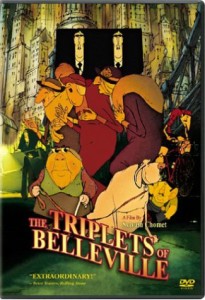
view/request
Sylvain Chomet’s feature-length animated film is like nothing you’ve ever seen. It’s weird, funny, sad, serious, lighthearted, suspenseful, perverse, sweet, surreal, retro, postmodern, and fantastic (in both senses of the word). There is virtually no dialogue, but there is music, adventure and character aplenty. The animation is hand-drawn and loaded with sophisticated detail. There are homages to Fred Astaire, Josephine Baker, Jacques Tati, the Andrews Sisters, and Django Reinhardt. The plot is quite satisfying, yet the style is the overwhelming story here. Despite the near-total absence of language, it could only be French. I have seen it three times so far and haven’t begun to get tired of it.
Reviewed by Faith
Tagged: Animation, Feature film, Foreign film
Bossypants
by Tina Fey
[Book]
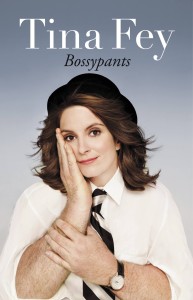
view/request
SNL and 30 Rock star, writer and producer Tina Fey is as smart and irreverent as she is funny. This memoir gives an inside look at the improv comedy incubator Second City, developing material for Saturday Night Live, and how Fey and her contemporaries broke through the glass ceiling of comedy.*
Here in a quick engaging read is an honest tongue-in-cheek and witty look at success, motherhood, TV, sexism, and lots of famous people you may have been wondering about. A few classic scripts are included, notably the Sarah Palin/Hillary Clinton sketch that Fey and Amy Poehler did in the 2008 campaign season.
* “Women just aren’t funny.”–every male producer/director from the beginning of time.
Reviewed by Faith
Tagged: Comedy, Memoir, Non-fiction
The story of Vernon and Irene Castle
[DVD]
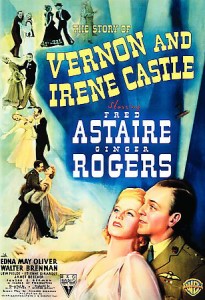
view/request
Based upon the true story of the celebrated husband and wife dancing team who popularized ballroom dance, this film is the most realistic, the most tragic, and the most touching of the Astaire-Rogers films. The film takes place in the years between 1911 and 1918, and the costumes and music are largely appropriate to that era. Most of the dance sequences emulate the Castle’s distinctive style—Astaire tap dances in only one number and Rogers not at all—and the musical numbers are fewer and more tightly integrated into the plot than in other Astaire films. Of course, the film still delivers what you expect from an Astaire-Rogers collaboration: Astaire is charming, the music is great, the dancing better, and the two stars may have better on-screen chemistry in this film than in any other.
Reviewed by Ben
Tagged: Comedy, Dance, Drama, Feature film
Guilt by Association
by Marcia Clark
[Book]
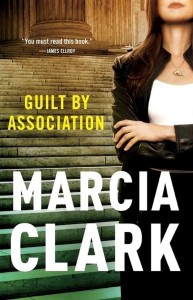
view/request
I was not expecting to like this book. I thought that this was a person taking advantage of name recognition to put out a book. Whether or not that is the case, I found myself genuinely engaged by the characters in this legal thriller. Los Angeles D.A. Rachel Knight is stunned at the death of her colleague, Jake Pahlmeyer, who is found shot to death in a sleazy motel along with a 17-year-old boy, raising ugly suspicions that Rachel doesn’t want to acknowledge. Rachel is warned off investigating further, but risks her career to clear her friend’s name. Quick-paced with plot turns and authenticity — the author does know her stuff, prosecutorily. Recommended and looking forward to the next in the series.
Reviewed by Molly
Tagged: Fiction, Legal thriller, Mystery
The Sharper Your Knife, The Less You Cry
by Kathleen Flinn
[Book]
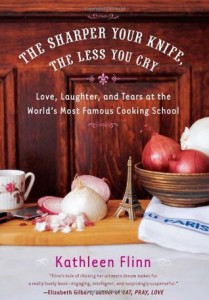
view/request
Flinn is an American journalist and computer executive in London and gets let go from a high power high stress job and decides to go to cooking school at the Cordon Bleu in Paris. When enrolling in cooking school, she set out to write a book about her experiences so this chronicles her year of self-discovery and finding love. It is full of humor, recipes and her adventures in a new country and language.
Reviewed by Julie
Tagged: Biography, Memoir, Non-fiction
The Purple Rose of Cairo
[DVD]
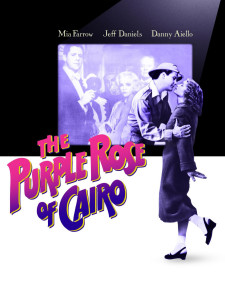
view/request
“You make love without fading out?” – Tom Baxter
The Purple Rose of Cairo is possibly my favorite Woody Allen film of all time… or perhaps tied with a couple other of his classics. In it we have some of his sharpest comedic screenwriting and a few concepts that will keep philosophy 101 students in discussion for decades to come.
It stars Mia Farrow as Cecilia, a woman struggling to support herself and her abusive, gambling and out of work husband (played by Danny Aiello) during the great depression. Her only escape from this drudgery is regular visits to the local cinema. When the lights dim, she gets whisked away in stories of adventure, romance and carefree living.
She particularly is enamored with the film the Purple Rose of Cairo (the film within our film!). Cecilia makes repeated trips to catch the Purple Rose and watches the story of bubbly society folk on an Egyptian expedition. After several viewings, she starts to notice slight inconsistencies with one of the character’s performance. Tom Baxter, played by Jeff Daniels, seems to be losing his timing and is possibly looking off into the audience. Eventually, he breaks character and talks to Cecilia from the screen. She nervously replies and Baxter walks out of the film and materializes in the theater.
The two dash off in a heap of commotion and the ex-film character appears to be the ideal romantic partner despite naïveté in real world dealings. His knowledge base consists of what was written for his character. For example, when dining, the couple are embarrassed to discover that Baxter’s cash supply is simply prop money.
Eventually, a surreal love triangle… or better yet, love square forms. When Gil Shepherd (also played by Jeff Daniels), the actor who portrayed Baxter, discovers that his character has left the film, he heads to New Jersey to convince his creation to re-enter The Purple Rose of Cairo. Whilst attempting to salvage his reputation and make everything go back to normal, Shepherd then falls for our leading lady. Does Cecilia leave her husband? Does she run off with the brave and compassionate, but fictional Tom Baxter? Or does she chose Gil Shepherd, the dashing and vain movie star?
Reviewed by Jason
Tagged: Comedy, Feature film
Histoire de Melody Nelson
by Serge Gainsbourg
[Music CD]
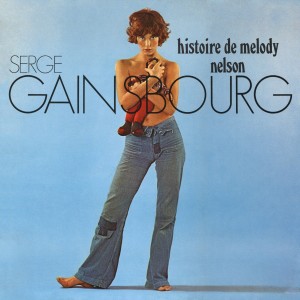
view/request
The master melodist and provocateur, Serge Gainsbourg introduced a revolutionary recording with 1971’s Histoire de Melody Nelson. The French pop star abandoned an archetypal singing style in place of a soft and nearly spoken word delivery. This was achieved by the singer’s smokey, baritone voice captured by close microphone placement. The music behind this voice is expressive and experimental with shades of psychedelia. Groovy (and yes, there’s really no other way of putting it) electric bass lines, freak out fuzz guitar and busy drums supply the basic tracks that are augmented by a choral and haunting string score by Jean-Claude Vannier.
Jane Birkin, Gainsbourg’s then wife, appears on the front cover and also provides the voice of Melody Nelson. You see, this is a concept record. It tells a Lolita-esque tale of a middle-aged man out driving who accidentally hits a bicycling British girl. The man falls in love with his victim and a love affair follows. Melody soon decides to fly home and the man, now devastated, performs an African Cargo Cult ritual to make his love return. His desperation proves to be tragic as he discovers that this act of mysticism caused an airplane crash.
The songs of Serge Gainsbourg, and the Melody Nelson album in particular, have inspired many musicians including Air, Jarvis Cocker, Beck, Portishead, Sean Lennon and the Divine Comedy. Rarely has the marriage of lyrical ingenuity and musical arrangement been achieved in popular music.
Reviewed by Jason
Tagged: French language, World music
The Saturday Big Tent Wedding Party
by Alexander McCall Smith
[Book]
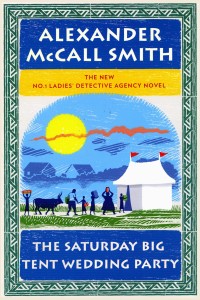
view/request
In the latest installment of the popular No. 1 Ladies Detective Agency series, Mma Grace Makutsi gets married, Mma Precious Ramotswe deals with a complicated case of attacks on a farmer’s cattle, and the tiny white van takes on a metaphysical dimension. McCall Smith’s characters handle the large and small dilemmas of life with a realistic mix of (mostly) good intentions and human vulnerability. His prose is charming and the loving portrait of Botswana, always in the background, makes you want to go there.
Reviewed by Faith
Tagged: Africa, Cozy mystery, Fiction, Mystery
The Sign of Four
by Sir Arthur Conan Doyle
[Graphic Novel]

view/request
I.N.J Culbard illustrates Ian Edginton’s adaption of Sir Arthur Conan Doyle’s The Sign of Four. This graphic novel takes on the second Sherlock Holmes story in which the famed detective and Doctor Watson must locate a mysterious stolen treasure. Holmes applies his trademark acute deductive reasoning skills while sprinkling in impatient and acerbic comments to all those within an earshot.
Being a longtime admirer of Doyle’s Sherlock Holmes stories, seeing the tale presented as a graphic novel is a quite a treat.
Reviewed by Jason
Tagged: Fiction, Mystery
The Ditty Bops
by The Ditty Bops
[Music CD]
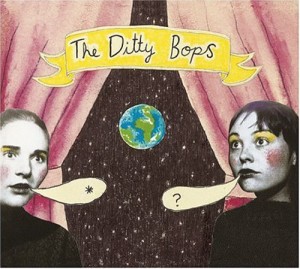
view/request
I enjoyed this band so much the first time I heard them (live, at Pearl Street) that I bought five copies of their self-titled album; I kept one copy for myself and gave the rest as Christmas gifts. This is fun music. Amanda Barret and Abby DeWald excel at quirky lyrics and tight vocal harmonies, and these two very competent musicians (in addition to their fine singing Abby plays guitar and Amanda plays mandolin and dulcimer) are backed up by an excellent band that really knows how to swing. They play in a variety of styles; swing, blues, and ragtime are among their more obvious influences.
I love the sound of this album, but I also love the words to many of the songs. The lyrics can change from nonsensical, to mundane, to profound all in the course of a song, and a song like “Walk or Ride” does all of these while addressing an issue that is dear to my heart.
Reviewed by Ben
Tagged: Folk music
Wordy Shipmates
by Sarah Vowell
[Audiobook]

view/request
A romp through Puritan history. Vowell, a commentator on NPR’s This American Life narrates this witty and sarcastic look at a small slice of Puritan history, intermixed with popular culture references. This quote from the book will give you a good sense of how she looks at history:
“I wish I didn’t understand why Hutchinson risks damming herself to exile and excommunication just for the thrill of shooting off her mouth,” writes Vowell. “But this here book is evidence that I have this confrontational, chatty bent myself.”
Includes music and quotes read by such luminaries as John Oliver from The Daily Show. 6 discs, 7 hours
Reviewed by Molly
Tagged: History, Non-fiction
The Red Shoes
[DVD]
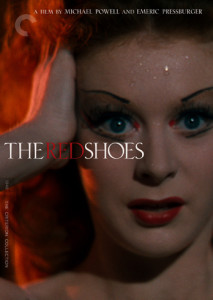
view/request
The Red Shoes is a visually stunning dramatic work about a ballet company led by the ruthless and contentious, but often charming director Boris Lermontov. Lermontov discovers dancer Vicky Page (portrayed by famed English ballet star Moira Shearer) at a society party and realizes her unparalleled potential. Before signing her to his company she must decide what role dancing plays in her life. Is it a passion she pursues or shall it consume her entirely? Can an artist love anything or anyone more than their craft? These conflicts becomes the underlying theme of the picture.
The Hans Christian Andersen story of The Red Shoes is the source in which the main ballet within the film is based. Instead of just viewing the performance from the theater audience’s perspective, Powell and Pressburger take the camera’s inside the action for a breathtaking, 17-minute sequence. We follow Page closely via dolly shots through various enormous, painted set pieces, close-ups of dancers movements and expressions and rich colored lights. The co-directors also chose to allow fantasy to be a part of the stage presentation as well with tasteful in camera visual effects.
The Red Shoes, which melodrama and beauty reach unbelievable heights, is a remarkable achievement in cinema.
Reviewed by Jason
Tagged: Ballet, Drama, Feature film












